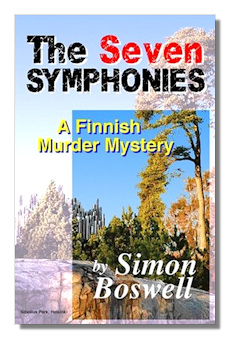
The Internet's Premier Classical Music Source
Related Links
-
Introduction
Acoustics
Ballet
Biographies
Chamber Music
Composers & Composition
Conducting
Criticism & Commentary
Discographies & CD Guides
Fiction
History
Humor
Illustrations & Photos
Instrumental
Lieder
Music Appreciation
Music Education
Music Industry
Music and the Mind
Opera
Orchestration
Reference Works
Scores
Thematic Indices
Theory & Analysis
Vocal Technique
Search Amazon
Recommended Links
Site News
 Book Review
Book Review
The Seven Symphonies

A Finnish Murder Mystery
Simon Boswell
Booklocker.com (2005) 449 pages
ISBN-10: 1591136520
ISBN-13: 978-1591136521
Miranda Lewis is the daughter of a deceased Finnish mother and an English musicologist who is an expert on the Finnish composer Jean Sibelius. It should come as no surprise that she is knowledgeable about music, and her sister Rosie is an accomplished cellist. Nor will you puzzle over her friendship with two Englishmen visiting Helsinki, the composer Adrian Gamble and his friend Phillip Burton. What you might not expect is that Miranda is a homicide detective on the Helsinki police force.
Soon after the novel opens, a young woman's body is discovered propped up against the famed Sibelius Monument in Sibelius Park with a noose around her neck, her little finger cut off, and her violin nearby. Miranda and her small team of officers are assigned to the crime.
I betray no confidences when I tell you Miranda is dealing with a serial killer. Nor that each murder is identified with a Sibelius symphony, each chapter is titled by a symphony, and all subchapters are headed by their symphony's movement names. Beyond that, each murder is followed by a letter to the police received c/o The Ainola Residence, Järvenpää – the one-time home of Sibelius until his death in 1958. The first letter's contents are typical: "Symphony No.1 in E Minor", a quotation from Sibelius' diary, a fingerprint of the victim's lost digit, and the signature, JS.
Besides the letters, Sibelius appears in lectures given by Miranda's father – one for each symphony – that present interesting insights into the composer. These lectures flesh out the novel and Miranda's character, while adding fascinating insights into Sibelius and his music that should interest even nonmusical readers. Boswell keeps the lectures short – too short for me. He actually goes so far as to bracket sections that uninterested readers can skip (though nothing in them is beyond the ken of an intelligent reader).
As the investigation proceeds, Miranda and her colleagues speculate, interview witnesses and suspects, talk to forensics people, listen to the theories of a profiler, follow frustrating dead-ends, all while seeking common ground among murders connected only by Finland's national composer. In due time, the police and the reader realize that they are working against the "clock" of Sibelius' seven symphonies. Boswell understands this and cleverly varies the terrain with each crime by introducing new characters, puzzles, and misdirection.
In the vortex of the investigation sits Miranda, whose personal life forms a second, and integral, front in the novel. It can be a challenge for a male author to present a story like this through the eyes of a female main character, and Boswell handles it convincingly. It's a good thing, too, because the story works much better with a female lead detective.
Seven Symphonies is a descendent of, if not equal in depth and rich prose to, those grand 19th-Century novels by the father of the detective novel, Wilkie Collins (specifically Woman in White and The Moonstone). Boswell's mature, nonmelodramatic style is absorbingly clinical, like the report of a literate, clear-headed investigator, as well as compelling – quite fitting for a detective novel by an Englishman set in modern urban Finland. The police investigation is scrupulously observed and fascinating in detail, to the point where the reader often feels like a fourth member of the investigative team. The characters discuss music, philosophy, the criminal mind, and sexual perversion (the latter always within the confines of the story and never as titillation) without ever taking us too far from the mystery. The Helsinki locations are well observed, and a helpful map is provided. Some scenes are graphic, but few readers familiar with contemporary detective fiction will be disturbed. In a short introduction, Boswell writes that his book is more a detective novel than a musical one. Indeed, the link between Sibelius and the killings is tenuous, though "non-musical" readers will not be bothered. Most will be happy to read one of the more intelligent mystery novels that have appeared in recent years.
Copyright © 2008 by Roger Hecht.


















